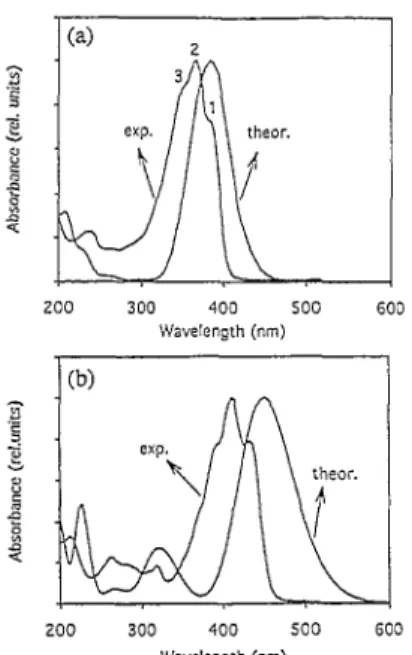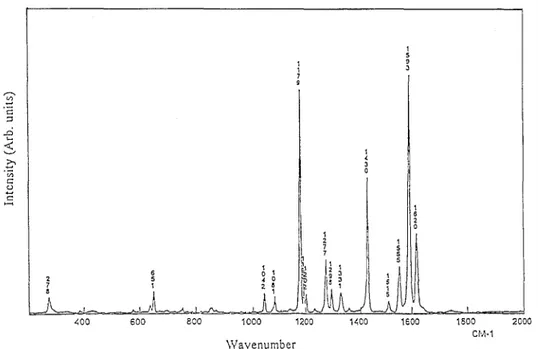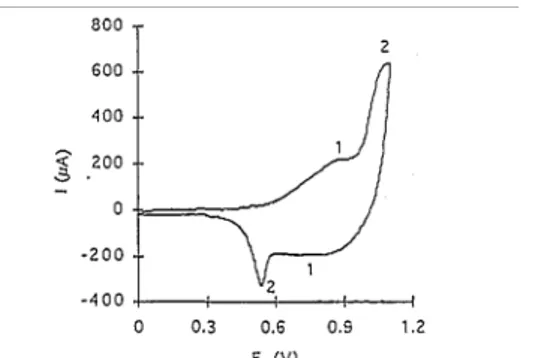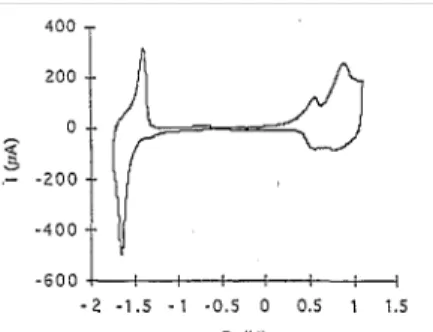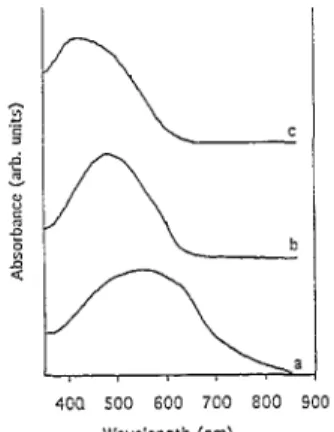Tilman, B-4000 Liège, Belgium (b) Service de Chimie des Materiaux Nouveaux et Centre de Recherche en Electronique et Photonique Moleculaires, Universite de Mons-Hainaut, place du Pare 20, B-7000 Mons, Belgium
Abstract
Highly conjugated thiophene derivatives, based on thienylene vinylene and thienylene vinylene phenylene units, have been synthesized in order to examine: (i) the effect of such regular conjugated monomer structures on polymer formation; and (ii) the optical and electrochemical properties of the corresponding macromolecules. The all-trans monomers have been prepared by a Wittig reaction. The polymers have then been synthesized electrochemically. The polymers are electrochromic and can be reversibly doped both oxidatively and reductively. Their electrochemical behavior and optical properties have been analyzed on the basis of a series of quantum-chemical calculations. Keywords: Electrochemical synthesis; Electronic structure; Conjugated polymers; Dithienylene vinylene derivatives
1. Introduction
Structural modification of conjugated polymer chains has proved to be useful for the synthesis of redox dopable electronically conducting polymers with a broad range of mechanical, electrical,
electrochemical and optical properties. Various derivatives of polyacetylene, poly(p-phenyl-ene), polypyrrole and polythiophene have accordingly been studied over the past decade [ 1-3].
The electropolymerization of heterocyclic monomers with formation of electrically conductive and redox active polymers is highly dependent on the monomer oxidation potential. In some cases, the monomer is oxidized at potentials that cause polymer degradation, leading to defect-containing
materials or even completely inhibiting polymerization. In the case of thiophene, this situation has been termed the polythiophene paradox [4], Electropolymerization of conjugated oligomer molecules provides a simple route to polyheterocycles of a higher purity, because this approach allows one both to decrease the monomer oxidation potential and to determine most of the linkages between the
heterocyclic entities. It is noteworthy that such oligomers have the potential of being electropoly- merized onto anodically corrodible metal substrates as a result of their lower oxidation polymerization potentials, compared to traditional monomers.
Moreover, starting from short oligomers tremendously increases the potential for designing the polymer electronic properties. Using organic synthesis, one can indeed combine at will various conjugated 'building blocks', such as vinylene units, phenylene, thiophene, or pyrrole groups. Since the electronic structure of conjugated alternating copolymers is directly related to the nature and the ratio of those 'building blocks' [5,6], the polymerization of appropriately designed mixed oligomers appears of particular interest for the control of both the bandgap and the redox potentials in conjugated macromolecules.
Following this approach, this paper describes the synthesis and the electronic properties of two novel conjugated polymers combining vinylene, thienylene and phenylene units. Since polymer formation from oligomers requires symmetric compounds end-capped by heterocycles with open α positions available for oxidative coupling reaction, we have synthesized 2,2'-dithienyl-ω,ω'-1,4-divinyl benzene (DTDVB) and 2,2'-dithienyl-ω,ω'-2,5-divinyl thiophene (DTDVT) (Scheme 1). The optical absorption spectra of these monomers have been recorded and compared to theoretical curves, in order to
rationalize the effect of substitution of the internal phenylene unit by a thiophene ring on the monomer electronic structure.
Scheme 1.
We also report on the electropolymerization of DTDVT and DTDVB and the main characteristics of the resulting electroactive polymers. The electrochemical and optical properties of the polymers are discussed on the basis of the theoretical values calculated for the polymer electronic properties (ionization potentials, electroaffinities and bandgaps).
2. Experimental 2.1. Chemicals
Thiophene (Janssen Chimica) was distilled before use. Tetrahydrofuran (THF) was distilled over the purple sodium/benzophenone complex before use. 1,4-Bis(chloromethyl)benzene (Aldrich), sodium hydride (Aldrich, 60% dispersion in mineral oil), 2-thiophene car-boxaldehyde (Janssen Chimica) and triethylphosphite (Fluka) were used without any purification. 2,5-Bis(chloromethyl)thiophene was synthesized as reported in the scientific literature [7]. The 1H and 13C NMR spectra were recorded with a Bruker AM 400 spectrometer operating at 400 and 100 MHz, respectively; the chemical shifts were measured with respect to tetramethylsilane (in the following, the coupling constants J are given in Hz). The IR spectra were recorded with a Perkin-Elmer 1600 FT spectrometer.
2.2. Monomer synthesis
Both monomers were successfully synthesized via a two-step reaction route [8-10]. Tetraethyl-l,4-phenyl-bis(methylphosphonate) [11] was obtained by the reaction of l,4-bis(chloromethyl) benzene with triethylphosphite at 120 °C (yield 98%). When reacted with sodium hydride in THF, followed by addition of 2-thiophene carboxaldehyde, this compound was converted into the desired 2,2'-dithienyl-ω,ω'-l,4-divinyl benzene in 68% yield (yellow powder, m.p. 269 °C (275 °C [8]). NMR (ppm, CDCl3) δ: 7.6 (4H, s), 7.54 (2H, d, J=16), 7.50 (2H, d, J=5), 7.27 (2H, d, J=3.3), 7.27 (2H, d d, J=5 and J=3.3), 7.03 (2H, d, J= 16). IR (KBr, cm-1): 3066, 3016, 2922,2852, 953, 826, 693.
Starting from 2,5-bis(chloromethyl)thiophene and following the same procedure, 2,2'-dithienyl-ω,ω'-2,5-divinyl thiophene was isolated as an orange powder, m.p. 148 °C (151°C [9]) (yield
42%).1HNMR(ppm,CDCl3) δ:7.18 (2H,d, J= 5),7.04(2H,d,J= 4),7.02(2H,d,J=16),6.98 (2H, d, J=4), 6.96 (2H, d, J= 16), 6.90 (2H, s). 13CNMR (ppm, CDCl3) δ: 142.3, 141.3, 127.7, 127.0, 126.1, 124.4, 121.6,121.4. IR (KBr, cm-1): 3066,2923,2853,1039,931, 856,817,691.
2.3. Electrochemical polymerization
Electrochemical polymerization and cyclic voltammetry were carried out with an EG&G Princeton Research model 273 potentiostat/galvanostat. Three platinum sheets were used as working, counter and pseudo-reference electrodes. Acetonitrile (ACN) was distilled over CaH2. Lithium per-chlorate and tetraethylammonium perchlorate (TEAP) were dried for 24 h under reduced pressure and used as supporting electrolyte. The monomer concentrations were 5 x 10-3 M for DTDVT and 10-4 M for DTDVB (due to limited solubility) and the electrolyte concentration was 0.1 M.
2.4. Optical spectroscopy
good estimates for the geometry of organic systems [12]. With this method, we have found that the DTDVT molecule is fully planar, while, in DTDVB, the central phenyl ring twists 15° out of the plane of the rest of the molecule. These conformations are maintained in the corresponding polymer chains. In the case of bithiophene and polythiophene, adjacent rings are tilted 27° with respect to each other. Based on those AMl-optimized geometries, the intermediate neglect of differential overlap (INDO) method [13], coupled to a single configuration interaction (SCI) technique [ 14], was then used to simulate the optical absorption spectra of DTDVB and DTDVT. The electronic configurations involved in the INDO/SCI formalism were generated by promoting one electron from the 20 highest-occupied molecular orbitals to the 20 lowest-unoccupied levels. The introduction of further levels did not modify the results in any significant way. The electron-electron repulsion terms were described via the Mataga-Nishimoto potential [15], which is appropriate to reproduce absorption spectra within the INDO/SCI technique. The theoretical spectra were obtained by means of a convolution with Gaussian lines whose full width at half-maximum was set at 0.2 eV.
Using the structural data for the optimized geometries of the polymers, the electronic structures of PDTDVB and PDTDVT were determined with the non-empirical valence effective Hamiltonian (VEH) method [ 16]. This technique was developed in order to obtain accurate estimates of the main electronic parameters of conjugated and nonconjugated polymers: bandgap (Eg), ionization potential (IP) and electron affinity (EA).
4. Results and discussion
4.1. Optical absorption spectra of the monomers
Fig. 1 shows the UV-Vis absorption spectra of the monomers, DTDVB and DTDVT, in ACN. The former exhibits a characteristic absorption peak at 372.5 nm and two additional bands at 240 and 205 nm, while, in the latter, the main band peaks at 407 nm and a series of low-intensity features appears between 350 and 200 nm.
The calculated absorption spectra are also shown in Fig. 1. In both compounds, there occurs an intense peak at low energy, together with several low-intensity lines at higher energy. This is in good
agreement with the experimental lineshape. The theoretical data indicate that the major absorption band is due to an excitation from the highest-occupied molecular orbital (HOMO) to the lowest-unoccupied (LUMO) electronic level The high-energy features are more complex, since each of them results from several configurations involving excitations among π and Π*levels, either delocalized over the whole molecule or localized on the rings.
Fig. 1. UV-Vis absorption spectra of DTDVB (a) and DTDVT (b); exper-imental (exp.); theoretical INDO/SCI simulation (theor.).
Experimentally, the main absorption clearly shows a fine structure which could be either of vibronic origin or due to a chemically unresolved mixture of cis-trans isomers. Several arguments point to the former hypothesis. First of all, the Wittig reaction used in the monomer synthesis usually leads to the all-trans product, which is confirmed by the 1H NMR spectrum. Secondly, the energy calculated for the first optical transition of the DTDVB isomers is 3.23, 3.49 and 3.64 eV for the all-trans, cis-trans and all-cis isomer, respectively. Accordingly, the splitting between peaks 1-2 and 1-3 should be 0.26 and 0.41 eV, respectively, which is inconsistent with the values measured from Fig. 1(a) (0.15 and 0.30 eV, respectively). Thirdly, the observed splittings agree with the energy of an intense vibrational mode observed at 1179 cm-1 (0.146eV) on the Raman spectrum (Fig. 2). This vibrational mode is the signature of the heterocyclic S-C bonds and C=C aromatic bonds. Finally, this fine structure is very similar to that observed for the corresponding poly(para-phenylene-vinylene) (PPV) oligomer, for which a vibronic origin has been experimentally established and theoretically rationalized [ 17]. We can therefore safely ascribe these features to a vibronic structure.
The main absorption peak in the spectrum of DTDVT (Fig. 1(b)) also shows a fine structure, as already observed by Geisleretal. [18].Based on the above-mentioned arguments, we also propose it to
correspond to a vibronic progression, in contrast to the previous interpretation [ 18].
The relative intensity of the components of the vibronic progression is related to the degree of geometrical relaxation of the molecules in the excited state. In both compounds, the , spectra are not dominated by the 0-0 transition, i.e. the transition between the lowest vibrational states (component 1 in Fig. 1(a) and (b)). The geometric relaxation in the excited state is therefore significant, since the 0-1 transition (component 2) is the most intense transition, as is the case for PPV oligomers [ 17]. Note that the possibility of reaching vibra-tionally excited states was not included in the calculations;
consequently, the position of the main peak in the theoretical curves is in best agreement with component 1 (0-0 transition).
4.2. Electrochemical polymerization
In addition to the polymerization of DTDVB and DTDVT, we have also considered the
electrochemical synthesis of polythiophene from bithiophene (BT), as a reference compound. In cyclic voltamperometric experiments, using a Pt working electrode, the monomers exhibit an anodic peak ; characteristic of the formation of radical cations, with onset - potentials of 1.2,1.08 and 0.88 V (versus Pt) for BT, DTDVB and DTDVT, respectively. (We have checked that the Pt
Fig. 2. Raman spectrum of DTDVB (powder).
The DTDVB and DTDVT monomers show significantly lower polymerization potentials than BT, in agreement with the calculated ionization potentials (see Table 1, where BT is the reference). This merely results from the smaller Π system of BT, which is accordingly less prone to oxidation than the two thienylene vinylene molecules. Both theory and experiment show that the oxidation potential is higher for DTDVB compared to DTDVT, because the phenylene unit, which is more aromatic than the thiophene ring, makes the π-conjugation along the backbone less effective.
It is interesting to note that the decrease in oxidation potential with respect to BT allows DTDVB and DTDVT to be electropolymerized onto anodically corrodible metals such as nickel. A PDTDVT film can actually be deposited before the anodic dissolution of the metal occurs, in contrast to what happens in the case of PBT. This point is being further investigated and will be reported elsewhere.
On the electropolymerization voltammogram of both monomers, a reduction peak is observed near 500 mV on the reverse scan as a result of the reduction of the oxidized polymer on the electrode surface (Fig. 3; curve A). As expected, on the second scan (curve B), the current originates at lower potentials as a result of the polymer oxidation on the electrode surface, followed by the monomer oxidation. The overall increase in current upon repetitive scanning can be explained by deposition of the conducting polymer which increases the effective surface area of the electrode, as argued elsewhere for other monomers [ 19].
Table 1 Theoretical (VEH) ionization potential (IP) and electrochemical polymerization potential (EOX) of the monomers, with respect to BT used as a reference
IP monomer (eV) Eox monomer (V)
BTa 0 0
DTDVB -0.56 -0.12
DTDVT -0.77 -0.32
a (IP)BT =5.85 eV and (E0X)BT= 1.2 V.
The electrodeposited polymer films have been carefully washed with ACN in order to remove the monomer excess and to investigate their electroactivity in monomer-free electrolytes. PDTDVT films studied with LiClO4 as a supporting electrolyte show electrochromic activity between 0.4 and 1 V with a reversible change in color from red to blue. The anodic current linearly changes with the scan rate as expected for electrochemically formed species that are precipitated onto the electrode surface [20,21 ] (Fig. 4).
The cyclic voltammogram of PDTDVT (Fig. 5) shows two oxidation and two reduction peaks that occur with a good reversibility. They may be attributed to the sequential oxidation and reduction to form polarons and bipolarons on the conjugated chains. Previous studies [22] of the electrochemical
oxidation and reduction of conducting polyheterocyclic films indicate that the sequential formation of polarons and bipolarons can occur at essentially the same potential. However, although potentials of these redox events are too close to each other for voltammetry to discriminate them, variations in the electrolyte medium and temperature can be responsible for a low potential shoulder on the anodic scan.
Fig. 3. Cyclic voltammogram of DTDVT in 0.1 M LiClO4 at 50 mV/s: (A) first scan; (B) second scan.
Fig. 4. Dependence of the oxidation current intensity on the scan rate (υ) as measured by voltammetry on PDTDVT and PDTDVB thin films in 0.1 M LiClO4.
Fig. 5. Cyclic voltammogram of a PDTDVT thin film in 0.1 M LiClO4 at 50 mV/s.
Enhanced counterion mobility is thought to decrease the potential of the neutral-to-polaron redox event and to make it distinguishable from the polaron-to-bipolaron response. Child and Reynolds [23] have also observed this peak separation in the case of ether-substituted polythiophene. For that system, they have shown that polaron and bipolaron formation is controlled by the potential rather than by an ion-transport phenomenon. In the case of PDTDVT, the same conclusion is expected to hold since there is no reason for a more efficient ion-transport compared to PBT.
PDTDVB has been studied under the same electrochemical conditions as PDTDVT. The color of the thin films reversibly changes from orange to blue between 0.4 and 1V. The current shows a linear dependence on the scanning rate, with a slope which is very similar for the two polymers under consideration (Fig. 4). By taking the following equation [20] into consideration, it appears that the same amount of polymer is electrodeposited in the two cases:
where A is the electrode surface, Γ0 is the molar amount of the adsorbed compound on the surface during the potential sweep, υ is the scanning rate, ip is the current peak intensity, n is the number of electrons exchanged during the reaction and F is the Faraday constant.
peak is observed, which corresponds to an irreversible reaction responsible for a decrease in polymer electroactivity. This peak is assigned to the overoxidation of the polymer film. It is thus essential to keep the switching potential below 1.2 V in the course of the electropolymerization, so as to avoid overoxidation and deactivation of the polymer. PDTDVB is less stable than PDTDVT, for which the overoxidation peak appears only at 1.6 V.
The first oxidation potential for each polymer is smaller compared to PBT, in agreement with the calculated ionization potentials (Table 2). This difference cannot be accounted for by differences in the conjugation lengths, as was the case for the parent monomers, since the three polymers must contain fairly long conjugated segments (and since calculations are based on regular infinite chains). The chemical structure of the basic polymer units should rather be invoked. The PDTDVT structure formally corresponds to the insertion of vinylene units in the all-thiophene backbone of PBT, which is known to reduce the oxidation potential [24]. This effect is due to the Π electrons of the vinylene double bond which tend to interact more strongly with the neighboring Π system and enhance
electronic derealization of the frontier levels, resulting in an increase of the width of the upper valence band and thus in a decreased oxidation potential. The enhancement of electronic derealization is less pronounced in PDTDVB with respect to PDTDVT, because the Π electrons within the phenylene rings tend to remain more localized than those in the less aromatic thiophene rings. The oxidation potential of PDTDVB is accordingly in between those of PBT and PDTDVT.
The ability of these polymers to be electrochemically n-doped has also been investigated. We have clearly observed n-doping in a 0.1 M TEAP solution in ACN: these films turn .reversibly from red to blue in the cathodic scan and the vol-tammetric curve (Fig. 6) indeed shows the corresponding peaks. In contrast, the n-doping of PDTDVT and PDTDVB films has failed in a 0.1 M LiClO4 solution in ACN. No reversible peak is observed during a cathodic scan and no characteristic blue color for the doped polymers is detected. Instead, irreversible alteration of the electroactivity of the polymers is observed.
It is well known that the cation of the supporting electrolyte plays a major role [25] in the n-doping process. Indeed, the polymer chains are negatively charged and the electroneu-trality is preserved by cations incorporated into the films.
Fig. 6. Cyclic voltammogram of a PDTDVT thin film in 0.1 M Et4NClO4 at 50 mV/s.
On voltammograms such as that shown on Fig. 6, we can measure the difference between the onset of the anodic oxidation peak (p-doping) and the cathodic reduction peak (n-doping); the two values correspond to the lowest energies required to extract and to inject an electron in the polymer, respectively. Accordingly, an approximate 'electrochemical value' can be measured for the polymer bandgap, i.e. 1.7 eV for PDTDVT and 1.85 eV for PDTDVB.
4.3. Evolution of the bandgap
The polymer bandgaps have also been estimated from the onset of the absorption spectrum in the neutral state (Fig. 7). The polymers show a bathochromic shift (compared to the monomers) with λmax shifting from 372.5 to 423 nm in the case of DTDVB and from 407 to 562 nm for DTDVT, as expected for highly conjugated structures. It must be noted that the fine structure observed for the monomers disappears in the polymer spectra, probably as a result of some structural disorder (note that this does not preclude the presence of an underlying vibronic progression).
Nevertheless, the polymers show a distinct Π to Π*transition with a bandgap onset of 1.87 eV for PDTDVB, 1.55 eV for PDTDVT and 1.85 eV for PBT. These optical values are in good agreement with the electrochemical data (Table 3). The theoretical values are also consistent with the optical absorption data; the fact that the calculated bandgaps are systematically lower than the experimental data may be due to the presence of some structural disorder in the actual polymers, whereas infinite regular chains are considered in the calculations.
Fig. 7. UV-Vis absorption spectra for the neutral polymers (thin films on ITO): (a) PDTDVT; (b) PBT; (c) PDTDVB.
Table 3 Electrochemical, optical and theoretical (VEH) energy gaps of the polymers Electrochem.
(eV)
Optical (eV) Calc. (eV)
PBT 1.85 1.85 1.68 PDTDV B 1.85 1.87 1.69 PDTDV T 1.70 1.55 1.37
Nevertheless, very similar bandgaps are calculated for PBT and PDTDVB, significantly higher (about 0.3 eV) than for PDTDVT, in good agreement with the measurements.
This difference can be explained on the basis of the arguments used above in the discussion of the oxidation potentials. Compared to PBT, only small changes are expected for PDTDVB, since the effects of the vinylene units and the phenylene rings on the electronic structure tend to cancel each other. In contrast, only vinylene units in PDTDVT are at work and the bandgap significantly decreases with respect to PBT [26].
The results reported in this paper are also consistent with the observations published for related compounds [27,28]. The bandgap of PDTDVB is smaller than in PTBT (thio-phene-benzene-thiophene; Egopt = 2.2 eV) due to the presence of the vinylene groups. For the same reason, PTVT (thiophene-vinyl-thiophene; Egopt= 1.8 eV) has a larger gap than PDTDVT, in agreement with a vinylene/thiophene ratio which is larger for PDTDVT (2:3) than for PTVT (1:2). This also confirms that compounds containing no phenylene group have lower bandgaps, as expected from the calculated values.
5. Synopsis
The Wittig reaction scheme has been used to synthesize two all-trans thienylene vinylene derivatives. As a first step, the optical and electrochemical properties of these monomers have been rationalized on
C.J. and CM. thank the 'Fonds de la Recherche pour l'industrie et 1'Agriculture' (FRIA) for a fellowship. R.L. is chercheur qualifié du Fonds National de la Recherche Scien-tifique (FNRS). The authors are grateful to the 'Services Fédéraux des Affaires Scientifiques, Techniques et Culturel-les' for general support in the frame of the 'Pôles d'Attraction Interuniversitaires: Polymères et Catalyse, et Chimie Supra-moléculaire'. The collaboration between Mons and Liege is partly supported by the European Commission (Human Capital and Mobility Network: Functional Materials Organized at Supramolecular Level); the work in Mons is also supported by FNRS-FRFC and an IBM Academic Joint study.
We are also indebted to Professor B. Gilbert (University of Liege) for assistance with Raman spectroscopy and to Dr D. Beljonne (University of Mons) for providing the theoretical absorption spectrum of DTDVT.
References
[ 1 ] E. Brillas, J. Carrasco, A. Figueras, F. Urpi and T. Otero, J. Electroanal.Chem., 392 (1995) 55-61.
[2] J. Reynolds, A. Katritzky, J. Soloducho, S. Belyakov, G. Sotzing andM. Pyo, Macromolecules, 27 (1994) 7225-7227. [3] T. Mitsuhara, K. Kaeriyama and S. Tanaka, J. Chem. Soc, Chem.Commun., (1987) 764-765.
[4] B. Krische and M. Zagorska, Synth. Met., 28 (1989) C263.
[5] F. Meyers, A J. Heeger and J.L. Bredas, J. Chem. Phys., 97 (1992)2750.
[6] D.A. Dos Santos, C. Quattrocchi, R.H. Friend and J.L. Bredas, J. Chem.Phys., 100 (1994) 3301. [7] J. Grigging and L.F. Salisbury, J. Am. Chem. Soc, 70 (1948) 3416-3419.
[8] A. Heller, J. Chem. Phys., 40 (1964) 2839-2850.
[9] J. Nakayama and T. Fujimori, Heterocycles, 32 (1991) 991-1002.
[10] L.Ya. Malkes, R.A. Minakova and L.V. Kozyreva, Chem. Heter.Compounds (Engl. Transl), 15 (1979) 729; L.Ya. Malkes, R.A.Minakovaand L.V. Kozyreva, Khim. Geterotsikl. Soedin., 15 (1979)
895-897.
[11] N.N. Mel'nikov, Ya.A. Mandel'baum and Z.M. Bakanova, J. Gen.Chem. USSR (Engl. Transl.), 31 (1961) 3687-3689; N.N. Mel'nikov,Ya.A. Mandel'baum and Z.M. Bakanova, Zh. Obshch. Khim., 31
(1961)3953-3955.
[12] M.J.S. Dewar, E.J. Zoebisch, E.F. Healy and J.J.P. Stewart, J. Am.Chem. Soc, 107(1985) 3902. [13] J.A. Pople, D.L. Beveridge and P.A. Dobosch, J. Chem. Phys., 47(1967)2026.
[ 14] M.C. Zerner, G.H. Loew, R.F. Kichner and J. Mueller-Westerhoff, J.Am. Chem. Soc, 102 (1980) 589. [ 15] N. Mataga and Z. Nishimoto, Z. Phys. Chem., 13 (1957) 140.
[16] J.L. Bredas, R.R. Chance, R. Silbey, G. Nicolas and Ph. Durand, J. Chem. Phys., 75 (1981) 255; J.L. Bredas, R.R. Chance, R. Silbey, G. Nicolas and Ph. Durand, J. Chem. Phys., 77 (1982) 371.
[17] J. Cornil, D. Beljonne, Z. Shuai, T.W. Hegler, I. Cambell, D.D.C.Bradley, J.L. Bredas, C.W. Spanglerand K. Mullen, Chem. Phys. Lett.,247(1995)425.
[18] T. Geisler, J. Petersen, T. Bjornholm, E. Fischer, J. Larsen, C. Dehu, J.L. Brédas, G. Tormos, P. Nugara, M. Cava and R. Metzger, J. Phys.
Chem., 98 (1994) 10 102-10 111.
[19] L.Funt and S.Lowen, Synth. Met., 11 (1995) 129-137.
[20] A.J. Bard and L.R. Faulkner, Electrochemical Methods, Wiley, New York, 1980. [21] P. Marque, J. Roncali and F. Gamier, J. Electroanal. Chem., 218 (1987) 107-118. [22] G. Zotti and G. Scniavon, Chem. Mater., 3 (1991) 62.
[23] A. Child and R. Reynolds, J. Chem. Soc, Chem. Commun. (1991) 1779-1780.
[24] S. Yamada, S. Tokiio, T. Tsutsui and S. Saito, J. Chem. Soc, Chem. Commun., (1987) 1448-1449. [25] K. Kaneto, S. Ura, K. Yoshino and Y. Inuishi, Jpn. J. Appl. Phys., 23 (1984) L189.
[26] H. Ho, H. Brisset, P. Frere and J. Roncali, J. Chem. Soc, Chem. Commun., (1994) 2309-2310.
[27] J. Roncali, C. Thobie-Gautier, E. Elandaloussi and P. Frere, J. Chem. Soc, Chem. Commun., (1994) 2249-2250. [28] J. Reynolds, J. Ruiz, A. Child, K. Nayak and D. Marynick, Macromolecules, 24 (1991) 678-687.
